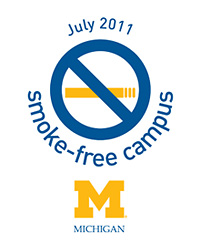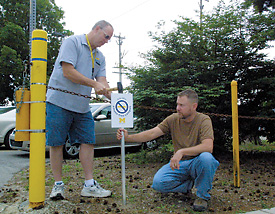
In less than two weeks all buildings, facilities, grounds and university-owned vehicles will become smoke free.
As the deadline gets closer, some are asking what to do when they encounter someone who is not adhering to the new policy. Smokers also want to know where they can go to light up without violating the new rules that take effect July 1.
University Human Resources and the MHealthy team have created a Supervisors’ Toolkit to answer the question of what to do when someone is smoking on campus. The resource, posted on the smoke-free website, smokefree.umich.edu, offers advice to those who manage staff, and to employees who may witness peers, students or visitors not adhering to the ban.
“The important message in all of this is that we want people to be respectful in their approach, and to assume first that the violation may simply be out of a lack of knowledge about the new policy,” says Kathleen Donohoe, associate director for HR strategy, planning and policy. “We are asking for voluntary cooperation with the new policy, and we are confident the faculty, staff, students and visitors will adhere to the new rules.”
At the same time, the toolkit offers advice to supervisors on what to do about repeat offenders, Donohoe says.

Kevin John, left, a sign painter from Construction Services, completes installation of a smoke-free notice with the assistance of Scott Becklehamer, a sign maker from the same unit. Photo by Todd McKinney.
Employees who disregard the policy will receive counsel from their supervisors in the same way other university policies are enforced. Repeated student smoking violations will be directed to the Office of Student Conflict Resolution (www.oscr.umich.edu).
President Mary Sue Coleman announced the plan to go smoke free in April 2009. The last two years have been dedicated to seeking feedback from all constituencies, and developing plans for implementation. Final recommendations for how to proceed with the ban were announced in January of this year (see www.ur.umich.edu/update/archives/110124/smokefree).
The new policy is posted as SPG 601.4 and includes the following exceptions:
• Smoking in university facilities will be permitted for controlled research, educational, theatrical or religious ceremonial purposes, with prior approval of the dean or director responsible for the facility.
How to approach a smoker, from the Supervisor’s Toolkit
• Remember to be respectful, asking whether the individual is aware of our smoke-free environment policy.
• If you encounter a smoking visitor, you may want to show the person where it is OK to smoke.
• If talking to the person is uncomfortable, consider handing the smoker a pocket card that explains the policy. These can be downloaded from the smoke-free website.
Where can smokers go?
The sidewalks that border public thoroughfares are not included in the smoking ban. For example, this means:
• Someone can smoke on the sidewalks that border South University Avenue but cannot smoke on the walkways of the Diag.
• Smoking is allowed on the sidewalk along Murfin Road on North Campus but is not permissible in the parking lot of the Walgreen Center.
• Smokers can go to the sidewalk in front of the Michigan Union bordering South State Street but cannot smoke in the circle drive that is at the back of the building.
Smoking in personal vehicles is allowed but the policy says that the windows must be rolled up. Smoking is not allowed in university vehicles.
• Smoking in privately owned vehicles with the windows up and on sidewalks adjacent to public thoroughfares is allowed.
“Some questions have come through the smoke-free website and other sources, indicating that people need help with the definition of public thoroughfares,” says Dr. Robert Winfield, chief health officer and co-chair of the Smoke-Free University Initiative.
Thoroughfares generally are those city streets — or campus streets in areas like North Campus — that vehicles can travel from one destination to another. Not included are driveways, parking lots, loading docks or pathways in areas like the Diag, he explains.
Facilities and Operations has been putting up signs across campus indicating where smoking is not allowed. At the same time, cigarette receptacles from campus have been moved to areas along sidewalks where smoking is not prohibited. Facilities and Operations also is creating maps to mark the thoroughfares to help people find the places that are not included in the ban. When finished, they will be posted on the smoke-free website.
“The goal of the smoke-free university is to improve overall health on U-M’s campus,” Winfield says. “Already a number of people have decided to take this as an opportunity to quit smoking. As we approach the deadline, we anticipate more may wish to work toward quitting, and the university is ready to help.”
Faculty and staff can get help through MHealthy at www.hr.umich.edu/mhealthy/programs/tobacco, which includes information about the U-M Tobacco Consultation Service, current health plan offerings and available online programs. Students can receive assistance through the University Health Service and the Tobacco Consultation Service, www.uhs.umich.edu/tobacco.

